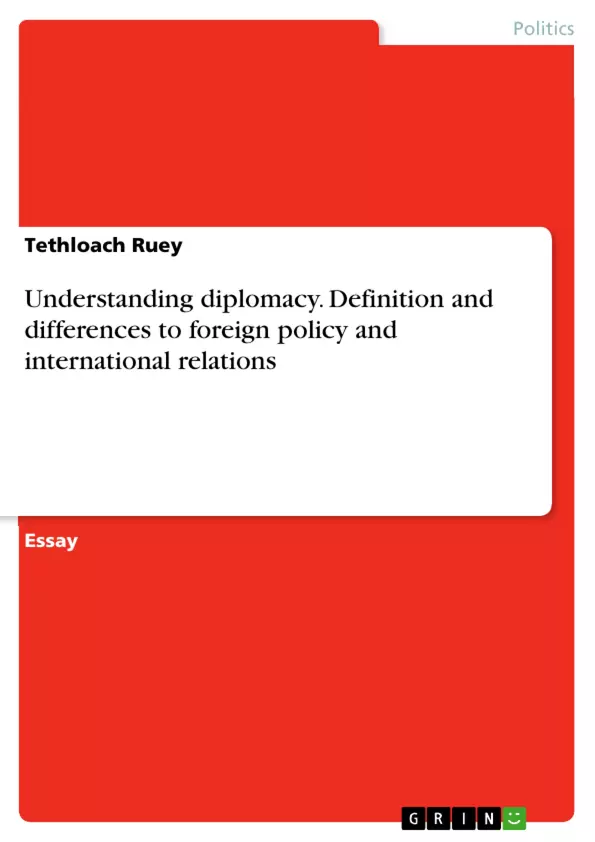In the diplomacy literature, both practitioners of and theorists regarding diplomacy provide several definitions of diplomacy that are state-centric, omitting non-state actors. However, any definition of diplomacy has to be inclusive because non-state actors also participate in diplomacy. There are also misconceptions about the differences between diplomacy, foreign policy, and international relations (IR).
Therefore, this essay provides a comprehensive definition of diplomacy and explains the differences between diplomacy, foreign policy, and IR. The diplomacy literature is reviewed in order to achieve these aims.
Table of Contents
- Introduction
- Defining Diplomacy
- Diplomacy, Foreign Policy, and International Relations
- Who Formulates Foreign Policy?
Objectives and Key Themes
This essay aims to provide a comprehensive definition of diplomacy and clarify the distinctions between diplomacy, foreign policy, and international relations. It critiques existing state-centric definitions of diplomacy and expands the understanding of diplomatic actors to include non-state entities.
- Defining Diplomacy: Critiquing existing definitions and proposing a more inclusive one.
- The Role of Non-State Actors: Examining the increasing participation of non-state actors in diplomacy.
- Differentiating Diplomacy, Foreign Policy, and International Relations: Clarifying the relationship between these three concepts.
- Evolution of Diplomacy: Analyzing how the understanding and practice of diplomacy has changed over time.
- The Limitations of State-centric Views: Highlighting the flaws in traditional definitions that focus solely on state actors.
Chapter Summaries
Introduction: This introductory chapter sets the stage for the essay by highlighting the limitations of existing definitions of diplomacy, which largely omit the contributions of non-state actors. It establishes the essay's objective: to present a more comprehensive and inclusive definition of diplomacy, while also differentiating it from foreign policy and international relations. The chapter emphasizes the need to move beyond state-centric perspectives and acknowledge the evolving nature of diplomacy in the contemporary world.
Defining Diplomacy: This chapter presents a multitude of definitions of diplomacy from various scholars, many of which are state-centric. The author analyzes these definitions, noting their strengths and weaknesses. It points out a common flaw: the limitation of considering diplomacy solely as negotiation between states, neglecting other crucial aspects such as ceremonial functions, information gathering, and image management. This lays the groundwork for a more inclusive definition presented later in the essay. The chapter also touches on the evolving landscape of diplomacy, hinting at the growing role of non-state actors.
Diplomacy, Foreign Policy, and International Relations: (This chapter is not present in the provided text and would be added if the full text were available.)
Who Formulates Foreign Policy?: (This chapter is not present in the provided text and would be added if the full text were available.)
Keywords
Diplomacy, foreign policy, international relations, non-state actors, state-centric, negotiation, communication, transnational diplomacy, definitions of diplomacy, contemporary diplomacy.
Frequently Asked Questions: A Comprehensive Language Preview
What is this document about?
This document provides a preview of a longer text focused on diplomacy. It includes a table of contents, objectives and key themes, chapter summaries, and keywords. The preview emphasizes the need for a more inclusive definition of diplomacy that goes beyond traditional state-centric approaches and acknowledges the growing role of non-state actors.
What are the key themes explored in this text?
The key themes revolve around defining and redefining diplomacy. The text critiques existing definitions that primarily focus on state interactions, highlighting the limitations of such state-centric views. It then explores the increasing importance of non-state actors in diplomatic processes and aims to provide a broader, more inclusive understanding of diplomacy.
What is the objective of this text?
The main objective is to offer a comprehensive and inclusive definition of diplomacy. This includes differentiating diplomacy from foreign policy and international relations, while also critically examining existing state-centric definitions and emphasizing the role of non-state actors in shaping diplomatic practices.
What are the main chapters covered in the preview?
The preview summarizes the introduction and the chapter defining diplomacy. It also lists, but does not summarize, chapters on the relationship between diplomacy, foreign policy, and international relations, and on who formulates foreign policy. These latter chapters are not included in the preview text provided.
What is the argument regarding state-centric definitions of diplomacy?
The preview argues that traditional, state-centric definitions of diplomacy are inadequate. They fail to account for the significant contributions of non-state actors and neglect various aspects of diplomacy beyond state-to-state negotiations, such as ceremonial functions, information gathering, and image management.
What role do non-state actors play in diplomacy according to the preview?
The preview emphasizes the growing and increasingly important role of non-state actors in diplomacy. The text highlights the need to include these actors in any comprehensive definition of diplomacy.
How does this text differentiate diplomacy from foreign policy and international relations?
The preview indicates that a chapter dedicated to differentiating diplomacy from foreign policy and international relations is part of the full text, but this chapter is not included in the provided preview.
What are the key words associated with this text?
Key words include: Diplomacy, foreign policy, international relations, non-state actors, state-centric, negotiation, communication, transnational diplomacy, definitions of diplomacy, and contemporary diplomacy.
- Quote paper
- Tethloach Ruey (Author), 2017, Understanding diplomacy. Definition and differences to foreign policy and international relations, Munich, GRIN Verlag, https://www.grin.com/document/373969




